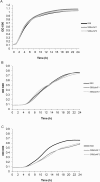ShiF acts as an auxiliary factor of aerobactin secretion in meningitis Escherichia coli strain S88
- PMID: 31847813
- PMCID: PMC6918656
- DOI: 10.1186/s12866-019-1677-2
ShiF acts as an auxiliary factor of aerobactin secretion in meningitis Escherichia coli strain S88
Abstract
Background: The neonatal meningitis E. coli (NMEC) strain S88 carries a ColV plasmid named pS88 which is involved in meningeal virulence. Transcriptional analysis of pS88 in human serum revealed a strong upregulation of an ORF of unknown function: shiF, which is adjacent to the operon encoding the siderophore aerobactin. The aim of this work is to investigate the role of shiF in aerobactin production in strain S88.
Results: Study of the prevalence of shiF and aerobactin operon in a collection of 100 extra-intestinal pathogenic E. coli strains (ExPEC) and 50 whole genome-sequenced E. coli strains revealed the colocalization of these two genes for 98% of the aerobactin positive strains. We used Datsenko and Wanner's method to delete shiF in two S88 mutants. A cross-feeding assay showed that these mutants were able to excrete aerobactin meaning that shiF is dispensable for aerobactin excretion. Our growth assays revealed that the shiF-deleted mutants grew significantly slower than the wild-type strain S88 in iron-depleted medium with a decrease of maximum growth rates of 23 and 28% (p < 0.05). Using Liquid Chromatography-Mass Spectrometry, we identified and quantified siderophores in the supernatants of S88 and its shiF deleted mutants after growth in iron-depleted medium and found that these mutants secreted significantly less aerobactin than S88 (- 52% and - 49%, p < 0.001).
Conclusions: ShiF is physically and functionally linked to aerobactin. It provides an advantage to E. coli S88 under iron-limiting conditions by increasing aerobactin secretion and may thus act as an auxiliary virulence factor.
Keywords: Aerobactin; Escherichia coli; ShiF; Siderophore.
Conflict of interest statement
The authors declare that they have no competing interests.
Figures




References
-
- Bonacorsi S, Clermont O, Houdouin V, Cordevant C, Brahimi N, Marecat A, Tinsley C, Nassif X, Lange M, Bingen E. Molecular analysis and experimental virulence of French and north American Escherichia coli neonatal meningitis isolates: identification of a new virulent clone. J Infect Dis. 2003;187:1895–1906. doi: 10.1086/375347. - DOI - PubMed
-
- Peigne C, Bidet P, Mahjoub-Messai F, Plainvert C, Barbe V, Medigue C, Frapy E, Nassif X, Denamur E, Bingen E, Bonacorsi S. The plasmid of Escherichia coli strain S88 (O45:K1:H7) that causes neonatal meningitis is closely related to avian Pathogenic E. coli plasmids and is associated with high-level bacteremia in a neonatal rat meningitis model. Infect Immun. 2009;77:2272–2284. doi: 10.1128/IAI.01333-08. - DOI - PMC - PubMed
-
- Lemaître C, Bidet P, Benoist J-F, Schlemmer D, Sobral E, d’Humières C, Bonacorsi S. The ssbL gene harbored by the ColV plasmid of an Escherichia coli neonatal meningitis strain is an auxiliary virulence factor boosting the production of siderophores through the shikimate pathway. J Bacteriol. 2014;196:1343–1349. doi: 10.1128/JB.01153-13. - DOI - PMC - PubMed
Publication types
MeSH terms
Substances
LinkOut - more resources
Full Text Sources
Medical

